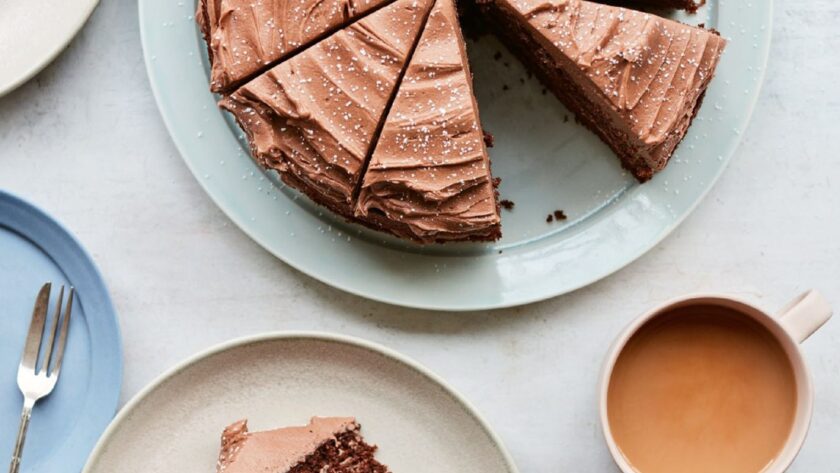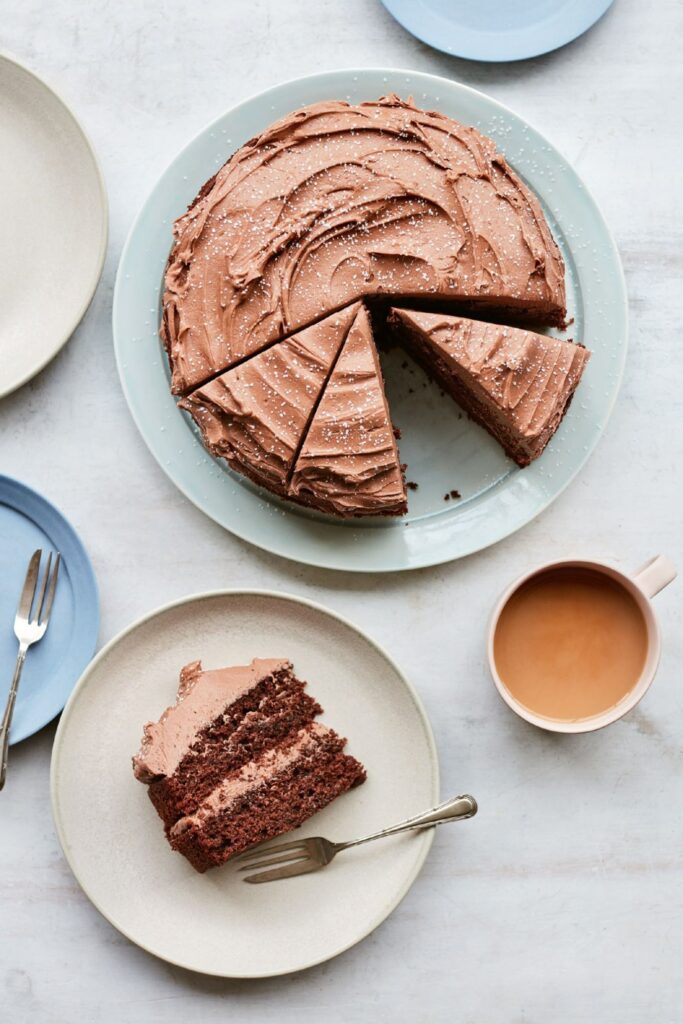I wasn’t sure about yoghurt in chocolate cake, to be honest. Thought it might make things weirdly tangy or too dense. But I gave it a go, and it surprised me—in a good way. The sponge came out soft and rich, but not heavy at all. The yoghurt just makes it moist without pushing it into overly sweet territory, and the cocoa keeps the flavour deep and dark.
Now, the icing? First time I blitzed it too long and it turned grainy—like chocolate cottage cheese. Not pretty. Turns out, you need to stop mixing just as it comes together. That’s the trick.
Here’s how I make it now—fluffy sponge, smooth icing, and not a dry bite in sight.
WHAT MAKES THIS RECIPE SPECIAL
What surprised me most was the texture. Most chocolate cakes either lean fudgy or dry out by day two. This one stays soft for days—and still slices cleanly. The yoghurt works with the baking powder to keep it lifted, and the all-in-one method means no faffing with creaming or folding.
Also: the cocoa flavour shines. It’s not overly sweet, thanks to the balance from the yoghurt and just the right amount of sugar.
INGREDIENTS + WHY THEY MATTER
- Baking Spread (75g) – Makes for a soft crumb. You can use unsalted butter if you prefer a richer flavour.
- Greek Yoghurt (200g) – Adds moisture and subtle tang. Full-fat is best. Low-fat made it a bit rubbery.
- Caster Sugar (300g) – Sweetens and stabilises the crumb. I’ve tested with golden caster—it adds a caramel note.
- Self-Raising Flour (175g) – Provides structure and lift.
- Cocoa Powder (50g, sifted) – Gives deep chocolate flavour. Always sift to avoid clumps.
- Eggs (3 large) – Binds and adds richness. Room temperature makes for better mixing.
- Baking Powder (1 tsp) – Extra rise to help with the heavier yoghurt-based batter.
- Milk (2 tbsp) – Just enough to loosen the mix to a smooth pour.
For the Icing:
- Butter (225g, softened) – Must be soft, or it won’t whip properly.
- Icing Sugar (300g, sifted) – Sweetens and stabilises. Sift for a smooth finish.
- Milk (2 tbsp) – Adjust for spreadability.
- Cocoa Powder (3 tbsp, sifted) – Rich, dark flavour. Don’t skip the sifting.
MAKING IT YOURS (WITHOUT RUINING IT)
- Want to use natural yoghurt? You can, but strain it first—too much liquid changes the texture.
- No cocoa? Try Dutch-processed, but reduce slightly—it’s stronger.
- Dairy-free? Use a dairy-free Greek-style yoghurt and baking spread. I’ve done it. Cake stays soft, but icing is trickier—go for a dairy-free butter brand that whips well.
MISTAKES I’VE MADE (AND HOW TO AVOID THEM)
| What Went Wrong | Why It Happens | How to Fix It |
|---|---|---|
| Cake stuck to the tin | Didn’t line the base | Always use baking paper in the tins |
| Icing turned grainy | Over-whizzed in the food processor | Blend just until smooth, then stop |
| Cake was too dense | Cold yoghurt or eggs | Use room temp ingredients |
| Sponge dry on day two | Slight overbake | Check at 25 mins and remove when springy |
HOW TO MAKE MARY BERRY’S CHOCOLATE YOGHURT CAKE
Heat the oven to 180°C (160°C fan). Grease and line two 20cm sandwich tins.
Chuck everything for the sponge into a big bowl and whisk it until the batter’s smooth and looks a bit airy.
Spoon the mix into the tins and smooth the tops out with the back of a spoon.
Bake for 25 to 30 minutes—don’t overthink it. You’ll know they’re ready when they spring back if you press the middle lightly.
Leave them in the tins for 10 minutes, then turn them out onto a wire rack and peel off the baking paper. Let them cool completely before you go near them with icing.
TIPS FROM MY KITCHEN
- I let the yoghurt sit out while I prep everything—cold yoghurt made the batter curdle once.
- Use a metal spoon or offset spatula to swirl icing neatly—it gives that bakery finish.
- If you’re using butter instead of baking spread, beat it first before adding other ingredients.
- I always test this cake at 25 minutes. A dry chocolate cake is a sad thing.
STORAGE + SERVING
- Store: In an airtight container in the fridge for up to 3 days. Bring to room temp before serving.
- Freeze: Wrap un-iced cake layers tightly and freeze for up to 3 months. Defrost overnight in the fridge.
- Serve with: A strong coffee or cold glass of milk. Works for birthdays, rainy days, or anything in between.
FREQUENTLY ASKED QUESTIONS
Q: Can I use plain yoghurt instead of Greek?
A: Yes, but it must be thick. If it’s watery, strain it first to match the texture of Greek yoghurt.
Q: Why is my icing grainy?
A: It was likely over-whizzed or made with cold butter. Stop mixing once it’s just combined and smooth.
Q: Can I bake this as a traybake instead?
A: Absolutely. Use a 9×13 inch tin and check around 20–22 minutes. Same batter, just one layer.
Q: Can I reduce the sugar?
A: A little—maybe by 30–50g—but too much and it’ll affect the moisture and rise.
Q: Can I make the cake a day ahead?
A: Yes, and you should. The flavour deepens, and the sponge stays lovely and moist.
Try More Recipes:
- Mary Berry American Chocolate Wedding Cake Recipe
- Mary Berry Chocolate Mirror Cake
- Mary Berry White Chocolate and Vanilla Cake
Mary Berry Chocolate Yoghurt Cake
Course: DessertsCuisine: BritishDifficulty: Easy8
servings15
minutes30
minutes300
kcalA rich, moist chocolate sponge made with yoghurt for extra softness and depth. Covered in smooth chocolate butter icing, this is a classic layer cake that’s easy to make but tastes like you bought it.
Ingredients
- For the Cake:
75g baking spread
200g Greek yoghurt
300g caster sugar
175g self-raising flour
50g cocoa powder, sifted
3 large eggs
1 level tsp baking powder
2 tbsp milk
- For the Chocolate Butter Icing:
225g butter, softened
300g icing sugar, plus extra for dusting
2 tbsp milk
3 tbsp cocoa powder, sifted
Directions
- Preheat the oven to 180°C (160°C fan). Grease and line two 20cm sandwich tins.
- Throw all the cake ingredients into a big bowl and whisk until the batter looks smooth and airy.
- Split it between the tins and even out the tops with a spoon or a quick shake.
- Bake for 25 to 30 minutes, until the sponges pull slightly from the sides and spring back when you press them gently.
- Let them cool in the tins for 10 minutes, then turn them out, peel off the paper, and leave them to cool completely.
- Blend the icing ingredients in a food processor just until smooth—stop before it goes fluffy or grainy.
- Spread half the icing on the first sponge, pop the second on top, and swirl the rest over the top.
Notes
- Use room temperature yoghurt and eggs for the best sponge texture
- Sift cocoa powder and icing sugar to avoid clumps
- Blend icing gently—overmixing makes it grainy

